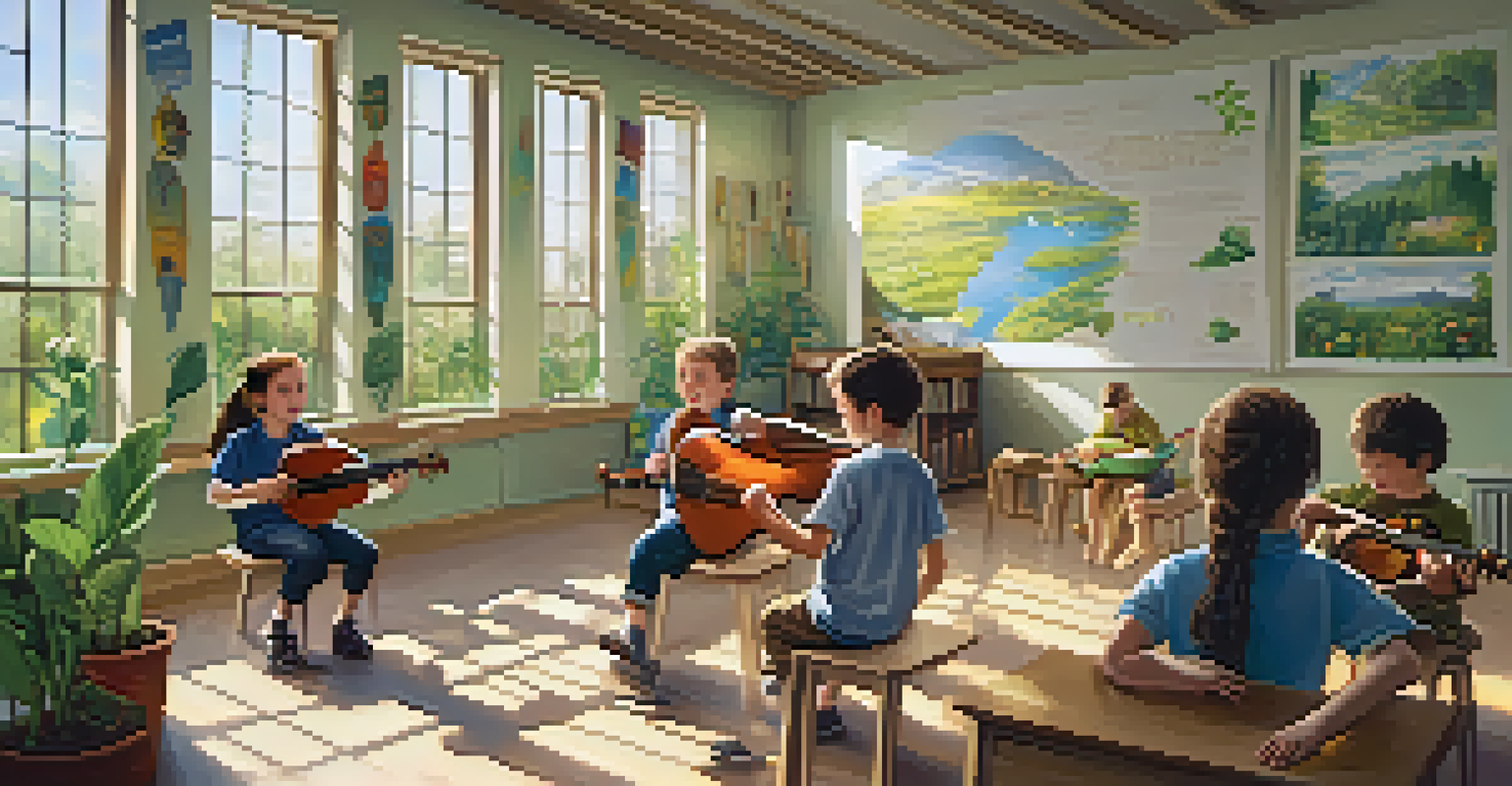Music as a Catalyst for Community Environmental Projects

The Powerful Connection Between Music and Community
Music has an innate ability to bring people together, transcending barriers of language and culture. This unique connection fosters a sense of belonging and shared purpose, which is essential for community-driven projects. When communities unite through music, they create a harmonious atmosphere conducive to collaboration and collective action.
Music can change the world because it can change people.
Consider a neighborhood organizing a clean-up day; the addition of a local band playing upbeat tunes can transform the event into a lively celebration. Participants feel more energized and engaged, which motivates them to contribute actively. This synergy between music and community spirit can lead to successful environmental initiatives.
Moreover, music serves as a universal language, allowing individuals from diverse backgrounds to connect over a common goal. This inclusivity is vital in addressing environmental issues, as it encourages everyone to participate regardless of their experience or knowledge level.
Music Festivals as Platforms for Environmental Awareness
Music festivals have increasingly become platforms for raising environmental awareness while entertaining diverse audiences. Many festivals incorporate eco-friendly practices, such as recycling programs and sustainable vendor options, inspiring attendees to adopt greener habits. These events not only showcase artists but also educate the public about important environmental issues.

For example, the Bonnaroo Music and Arts Festival has implemented a 'Green Team' that encourages festival-goers to engage in eco-conscious behaviors. The synergy of music and environmental advocacy creates a captivating atmosphere that motivates participants to consider their impact on the planet. This fusion of entertainment and education can lead to positive change long after the music ends.
Music Unites Communities for Action
Music has the power to bring people together, fostering collaboration and a sense of belonging in community-driven projects.
Additionally, the festival environment fosters a sense of community, where individuals can share ideas and collaborate on environmental projects. This camaraderie can spark conversations that lead to innovative solutions for local environmental challenges.
Local Musicians Rallying for Environmental Causes
Local musicians often play a pivotal role in galvanizing community support for environmental initiatives. By using their platforms to raise awareness, they can inspire fans and followers to take action. This grassroots approach has the potential to create a ripple effect, amplifying the message of sustainability throughout the community.
The power of music is that it can transport us to another time and place, creating connections that transcend boundaries.
Take, for instance, a local band that organizes a benefit concert for a nearby park restoration project. The event not only raises funds but also attracts attention to the environmental issue at hand, encouraging community members to get involved. The combination of music and activism can ignite passion and commitment to preserving local natural resources.
Furthermore, musicians frequently collaborate with environmental organizations, lending their talents to promote initiatives through concerts and community events. This partnership enhances visibility and creates a platform for dialogue about pressing environmental concerns, ultimately fostering a more engaged and environmentally conscious community.
The Role of Music in Educational Environmental Programs
Integrating music into educational programs can enhance learning experiences and promote environmental stewardship. Songs that focus on nature, sustainability, and conservation can engage students in a fun and memorable way. This approach not only captivates their attention but also helps solidify key concepts about environmental issues.
For example, schools that incorporate music-based lessons around conservation themes can inspire students to actively participate in eco-friendly projects. Whether it's creating eco-themed songs or organizing performances to spread awareness, music can be a powerful tool for teaching important lessons about the environment.
Festivals Raise Environmental Awareness
Music festivals increasingly serve as platforms for promoting eco-friendly practices and educating audiences about environmental issues.
Moreover, music encourages creativity and collaboration among students, fostering teamwork as they work together on environmental projects. This cooperative spirit can lead to innovative solutions and a deeper understanding of the importance of preserving our planet.
Community Events: Merging Music with Environmental Action
Community events that merge music with environmental action can create a festive atmosphere while promoting sustainability. For instance, a tree-planting event accompanied by live music can draw larger crowds and generate enthusiasm. The combination of rhythm, melody, and purpose can turn a simple gathering into a memorable experience.
These events not only beautify neighborhoods but also educate participants about the importance of trees in combating climate change. When attendees leave with both knowledge and a tree sapling, they’re likely to develop a deeper appreciation for their environment. The shared experience of enjoying music while engaging in environmental action creates lasting memories.
Additionally, these gatherings can serve as networking opportunities, connecting like-minded individuals who may collaborate on future projects. The bonds formed during these events can lead to ongoing community efforts that extend beyond the initial gathering.
The Global Impact of Music on Environmental Movements
Globally, music has been a driving force behind numerous environmental movements, uniting people in their fight for a sustainable future. Iconic events like Live Aid or Earth Day concerts have raised awareness and funds for critical environmental causes. These large-scale events demonstrate the power of music to mobilize communities and inspire action on a worldwide scale.
In various cultures, traditional music has been used to convey messages about nature and the environment, preserving indigenous knowledge and practices. This cultural connection to music reinforces the importance of protecting the planet for future generations, creating a sense of responsibility among community members.
Local Musicians Inspire Change
Local musicians play a crucial role in rallying community support for environmental initiatives through benefit concerts and partnerships.
Furthermore, global music collaborations often address pressing environmental issues, encouraging listeners to adopt sustainable practices. The impact of music extends beyond entertainment, serving as a catalyst for meaningful change across borders.
Challenges and Opportunities in Music-Driven Environmental Projects
While music can be a powerful catalyst for environmental projects, challenges still exist. Funding and resource allocation can hinder the execution of music-driven initiatives, making it crucial for organizers to seek partnerships and sponsorships. Additionally, finding the right musicians who are passionate about environmental causes can sometimes be a hurdle.
However, these challenges also present opportunities for creativity and collaboration. By leveraging local talent and community resources, organizers can design events that are both impactful and sustainable. Networking with local businesses and environmental organizations can help create a support system that enhances the overall effectiveness of music-driven projects.

As communities continue to recognize the importance of environmental stewardship, the potential for music to inspire action will only grow. With innovation and persistence, music can remain a vital tool in galvanizing support for environmental initiatives.